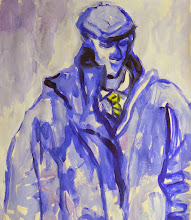The other week when my double-glazing fitters arrived I chopped down some gladioli which were planted right under the front window before they were trampled into the ground as I knew they would be. I kept them in a vase for over a week and each time I looked at them said: "I really must draw/paint these before they fade". But never quite got to them. My wife was asking me for days if she could throw them out yet since they were totally wilted and sad. I gave in at the weekend recognising the opportunity was gone. However, the idea was firmly planted in my head and yesterday when I was up at the supermarket I picked up these two bunches reduced in price to £1.50 ($3) each. It was only when I got home that I saw from the recipt that the checkout boy had only charged me for one bunch. I thought he looked a bit dozy that morning!
 Watercolour on paper, 56x76cm: "Red Gladioli"; Started with watersoluable colour pencils on a full imperial sheet of not paper. This is the first time I have painted in this way on a full-sized sheet feeling that I needed a bit of elbow movement to capture these long spikes.
Watercolour on paper, 56x76cm: "Red Gladioli"; Started with watersoluable colour pencils on a full imperial sheet of not paper. This is the first time I have painted in this way on a full-sized sheet feeling that I needed a bit of elbow movement to capture these long spikes.
Right now I'm off to Flickr to post these as "Gladioli for Dame Edna"!





14 comments:
:>) dreich is one of those words that just perfectly express what we mean
a local word is mardy - to describe sulky obsteporous spoilt bad tempered behaviour - mardy is a lot shorter
and so is dreich for wet and grey and damp and dark and soggy and miserable
Well worth the trip to the market to get these two fine images, David. Is your background plain paper, or did you paint gray washes?
Again, a feeling of one-breath on the leaves. One-breath is a sumi-e concept of completing a painting in a single exhalation -- it shows as a kind of confident, smooth gesture.
... and thanks to vivien for the translation... "two nations separated by a common language," and all.
With your love of the local landscape Vivien I can see you also enjoy, as I do, the colour of local language and dialect. I try to use auld Scots words, which my granny taught me, as often as I can to try in some way to keep them alive.
Thanks Edgar - I know now what you mean by "one breath" and can confirm that is the way I paint with watercolour taking a full brushload of colour and laying it on in one stroke without going over it if I can. I must try harder though 'cause I don't always achieve it!
The background is plain paper. I always have this argument with myself as to whether I should paint a background or simply leave the paper blank. Sometimes when I paint a background I lose the purity of line and form of the flowers that I like. You should check out Vivien's flowers - she knows how to do it!
We also have a highly acclaimed painter here in Scotland,(no, not me!), Elizabeth Blackadder, who does this style of painting which is derived from her appreciation of Japanese watercolours. See here:
http://www.thefineartcompany.co.uk/floral/floral-2.htm
and here:
http://www.artbank.com/DisplayArtist.aspx?id=30
ps: the grey shading and bright lighting on my pics is simply bad photography which I nevertheless liked and therefore retained!:o)
Blackadder's work is a very interesting blend of the two cultures -- the Japanese effect is subtle but very real. I studied some sumi-e back when I was working on calligraphy (and zen was bound to wear off on me with all the martial arts stuff I did), so I'm pretty sensitive to the touch of it. Looks like you're a natural.
I love the openness of the no-background. I use a quotation from Isaac Babel in my writing class: "Your language becomes clear and strong, not when you can no longer add, but when you can no longer take away." The question of how much is enough is always difficult to answer.
I also like the scale (once I translated into our wretched inches system). I've been thinking a lot about scale and format recently. I have a series that's mostly 12-inch squares (30cm) but recently added a panel that's 30 by 65 inches. It was very freeing. As a newcomer to this kind of wrok I'm finding these questions of scale and format very interesting.
I hope you have success with the window replacement. I recently had a leak from the tub in the 2nd floor bathroom decimate the ceiling in the first-floor bathroom. A house is an endless project.
So, Edgar, should I be calling you Master?
Glad you think I'm a natural. There are times I do draw and paint in a way that seems to be effortless (which makes up for the many other times when I couldn't draw my way out of a wet paper bag!) Early on when I started drawing seriously (about half-a-century ago!) I learned much from a book called "The Zen of Seeing" drawn and written by Frederick Frank, subtitled 'Seeing/drawing as meditation'. I must look to see if it is still in print. An invaluable book for all who wish to learn to draw.
What martial arts did you practice?
I've got you down as Black Belt Tai Chi (strength with gentleness).
Melanie: The new doors and windows are all finished now and looking terrific. They even keep the rain out! And I know how it is with leaky plumbing causing disasters to downstairs ceilings. As they say - Been there, done that!
With regards to scale I have always held the notion that size does indeed matter! I get very upset with artbooks that do not show the dimensions of an artwork. For me it is fundamental to understanding what exactly I am looking at. And to work to a larger scale is what I should be doing more of. As you say it is very freeing.
Too often I have ruined promising paintings by over elaboration. Yet I never know when to stop (a bit like my answers to blog comments, ha!). In these two paintings I very firmly had the work of Elizabeth Balckadder in mind knowing that this simplicity was what I desired.
Thanks both for commenting. I now need a cuppa tea and a long lie down in a darkened room.
Caio i miei amici!
Yup, the book is still in print and can be seen here: http://www.amazon.com/Zen-Seeing-Drawing-Meditation/dp/0394719689
Sadly I also read that Frederick Franck died in 2006 aged 97. So he did well and left a great legacy.
sorry -- I had too many typos in thee previous version (me, the writing teacher) so I thought I'd better refine my presentation. To wit:
Set a timer, when it buzzes, stop.
I'm not being facetious. You can go back to it later. Sometimes a break is instructive, sometimes you completley lose the thread, but it's an interesting practice -- at least, that's what I tell my young writers.
Thanks for stopping by the croft. I am drafting Part Two, I should be able to post by the weekend. I did lose the voice a little, but then it came back (see? see? start. stop. start. it can work. )
There we go. Just enough typos...
(sheesh)
Wonderful work, David. I like the very expressive brushwork and subtle variations in washes in your, greens, reds, and yellows. I've wrestled with the blank versus painted background question when working with flowers as well and tend to prefer the blank approach (or minimal neutral tones) so long as the negative spaces between flowers, leaves, et al is interesting. The open spaces in Red Gladioli seem particularly energized here. Glad to hear that the door and window replacement went well.
Thanks Brian! You are right - it's the dynamic of the negative spaces that (for me) are just about as important as the flowers themselves, and which I want to preserve cleanly.
Melanie: When you say you "..had too many typos" is that a kind of local refreshment?
Even with all those typos I can still figure out what you are saying about taking breaks and coming back to the work later. My problem (as you might guess) is that I get bored very quickly and when I come back to a painting the impetus has usually gone. I think that's probably why I prefer working alla prima!
Хотим с мужем купить [url=http://shkafy.com/vstroennye/]встроенные шкафы купе на заказ[/url] посоветуйте еще что нибудь, ассортимент продукции сейчас стал большой растерялась я
Post a Comment